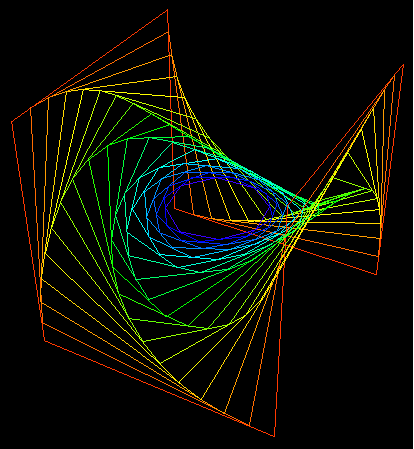| next curve | previous curve | 2D curves | 3D curves | surfaces | fractals | polyhedra |
3D PURSUIT CURVE
| Vectorial differential equation: |
The notion of pursuit curve refers to the trajectory of a moving mass M (the hunter) the motion of which is constantly oriented towards another moving mass M0 (the prey), the trajectory of which is called escape curve. In general, we consider that the motions of M and M0 are uniform, with speeds V and V0 = kV.
As can be expected, the hunter catches up with the prey with absolute certainty if and only if it runs faster than it (k < 1); when the two speeds are equal, the distance between the hunter and the prey goes to a constant a, and the curve of the hunter tends to become the tractory of that of the prey with a leash of length a.
We can also consider pursuit curves on surfaces: at every instant, the hunter moves along the geodesic of the surface that connects them to the prey.
Example: spherical pursuit curve ([Loria] p. 78).
The prey travels along a great circle, and at every instant,
the hunter moves along the great circle that connects them to the prey.
It can be proved that the differential equation of the
trajectory in spherical coordinates (q
= longitude, j = colatitude, when the
prey travels on the equator) is:

See the planar pursuit curves.
We can also generalize to space the mutual
pursuit curves ; here are two examples.

Made by Alain Esculier, anaglyph 3D to be looked at with red glasses (on the left) and blue (on the right) |

Sent by Emmanuel Amiot |
| next curve | previous curve | 2D curves | 3D curves | surfaces | fractals | polyhedra |
© Robert FERRÉOL 2018